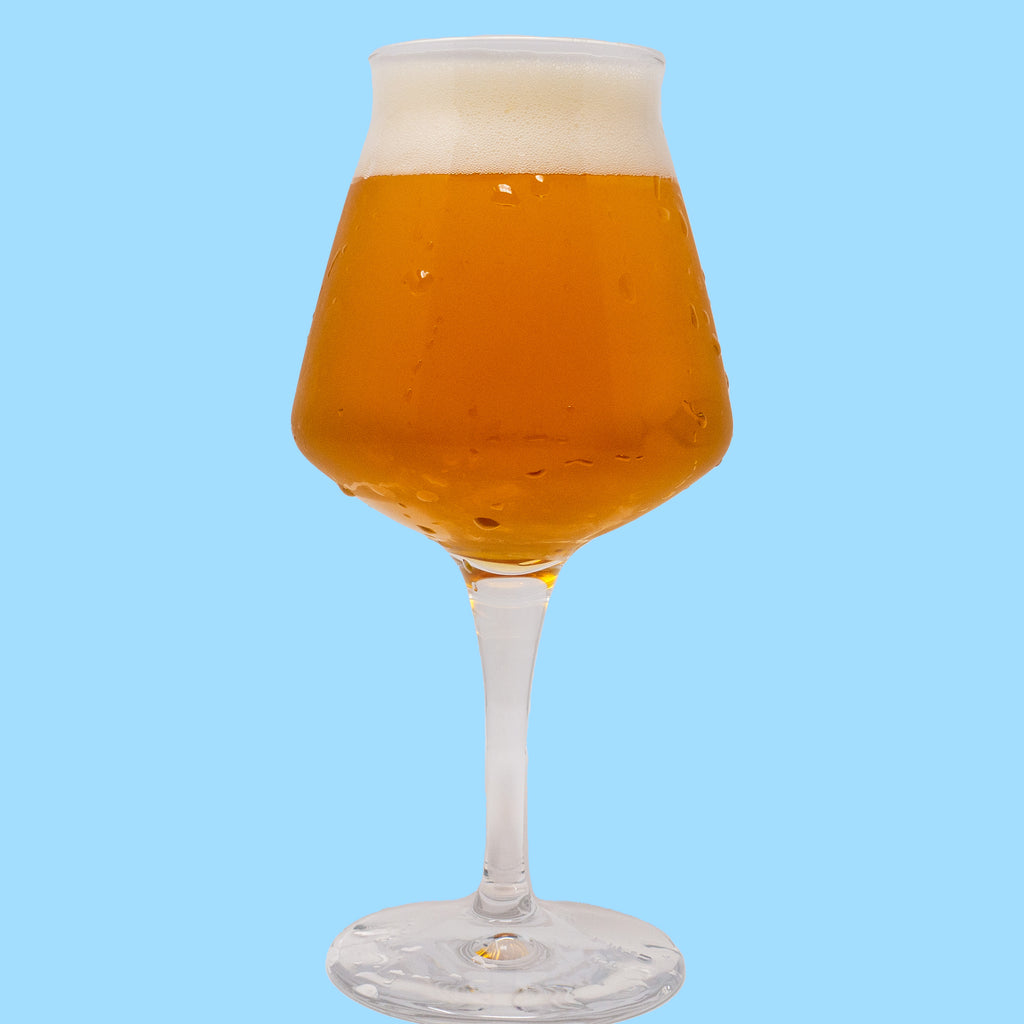INGREDIENTS & RECIPES
Try one of our peer reviewed recipes and ingredient kits! Each of these recipes are designed and hand crafted by the staff at KJ.
All kits include the required ingredients and instructions.
Try one of our peer reviewed recipes and ingredient kits! Each of these recipes are designed and hand crafted by the staff at KJ.
All kits include the required ingredients and instructions.
EQUIPMENT
Starter kits are a great way to get started brewing. Our different kits have everything you need to get that first batch cooking.
Starter kits are a great way to get started brewing. Our different kits have everything you need to get that first batch cooking.
Jean Claude Van Darn Good Belgian Golden Ale
May 30, 2022 7 min read

Beer of the Month Program
June 2022 - Jean Claude Van Darn - $42.99
Each month we release a new recipe for our Beer of the Month. They are always recipes that we have personally brewed ourselves, and have to pass a taste test amongst all of the staff here (tough job we know!). The recipes will be easy to make and we will gladly assist new home brewers in the production of these beers. They will all be 5.5 gallons in size. We find that after fermenting and racking a 5.5 gallon batch turns into a standard 5 gallon batch pretty quickly.
At the start of every month we will post the recipe in store, as well as on our website, Facebook, and Instagram. We will also have a set price for the recipe that will include a discount of up to 25%!
Jean Claude Van Darn Good Belgian Golden Ale
Belgian Golden Ale – 5.5 Gal - OG 1.060 – FG 1.012 – ABV 6.2% - IBU 18 – SRM 4
Purchase Online | Printable Instructions
Like all good recipes, this one started with a name, and recipe was built from there. This might seem like a backasswards way to create an official beer recipe – but we like to think of it like a writing prompt. The name gives us direction on where to take a new recipe. As we all know, Jean Claude is the famous Belgian kickboxer with the strong jawline and action hero chops from the 90s. He also does the splits really well. To commemorate such athletic prowess, we thought we’d brew a traditional Belgian style golden strong ale.
And boy oh boy did we ever brew a darn good strong golden ale. Dangerously smooth with great bready malt notes, balanced by the addition of noble hops and the Belgian style yeast from Escarpment labs. Classic Belgian flavours of banana, spice and bread make this complex, but also refreshing. Kumite!
In terms of production, this is an easy recipe to brew. The yeast – Wild Thing, is an easy-going yeast that can ferment safely between 18-25C, and despite its name it is NOT a sour/funk yeast.

|
Grains |
Amount (lbs) |
|
|
Pilsner |
7 |
|
|
Wheat Malt |
3 |
|
|
Flaked Wheat |
2 |
|
|
Chit Malt |
1 |
|
|
Acidulated Malt |
0.1 |
|
|
Hops |
Amount (oz) |
Hop Schedule |
|
Hallertau |
0.5 |
60 |
|
Hallertau |
0.5 |
30 |
|
Styrian Golding |
1 |
15 |
|
Yeast |
|
|
|
Wild Thing – Escarpment Labs |
1 Package |
|
|
Extras – Sold Separately |
|
|
|
Irish Moss |
1 tsp w/ 15 minutes left in boil |
|
|
DME/Dextrose |
170g at bottling for priming
|
(Target a CO2 level of 2.8) |
Important Tips on Brewing
- Be extra cautious when it comes to cleaning! Once you have stopped boiling your wort everything that gets in contact with the beer MUST be sanitary.
- The temperature of your mash is ABSOLUTELY CRITICAL. Not being in the 150-155f range can drastically affect your beer. Make sure you correct the temperature ASAP once all of the grain has been added to the mash.
- Always let your beer ferment for 10 days! Do not disturb it, do not open the lid. It is absolutely natural for the airlock to stop bubbling after a few days, it is still fermenting though.
- Oxidization: Airspace is always something to consider. When undergoing primary fermentation airspace is needed so that the beer can bubble up and ferment vigoursley without leaking out of the container. The fermentation creates a layer of CO2 that remains in the pail due to the airlock. Once primary fermentation is over, and the lid has been opened, the layer of CO2 dissipates, and oxygen replaces it. At this point airspace can ruin your beer. When racking into carboys make sure they are filled to the top, or you blast CO2 inside to prevent oxidization. Ask us for details on this!
- Before bottling, make sure you use a priming calculator (many can be found online) to verify the amount of sugar that needs to be added.
Instructions
(please note, most of these pictures are from other beers - but the beauty of brewing is that the majority of steps for brewing beers are very similar, and these photos are equally instructive for any style of beer.)
Mashing -> converting the grain into a fermentable liquid.
- Bring 6 gallons of water in your brew pot to 155°F. This is our strike temperature. Turn off the heat to the pot.
- Wrap the muslin/nylon bag around the brew pot and slowly pour all the milled grains into the bag. Stir them in while adding to prevent clumps. The addition of grain should drop the temperature down to 150-155°F.
- We want to mash the grain at 153°F for 60 minutes. It is very important to hold the temperature at 153°F. If the temperature rises above 155°F it hurts the fermentation, or if it dips below 149°F it can lead to a thinner tasting beer.
- The first 15-30 minutes are essential for the success of your brew. The temperature HAS TO BE IN THE RANGE OF 150-155°F. Sometimes adding the grain to the strike water does not lower the temperature enough, in this case add a little bit of cold water to bring the temperature down. Cover the pot with your lid and let it sit.
- Most brew pots will be able to maintain 153°F without adding heat for 20 minutes, we recommend checking the temperature every 15 minutes, and if it drops add more heat to bring it up. We recommend opening the lid and using a thermometer in the liquid.

- After 60 minutes, bring the temperature of the mashing grain up to 170°F and hold for 10 minutes. This is our mash out.
- Time to remove the grain. Lift the bag full of grain out of the brew pot. Let the liquid in the bag dribble into your wort. Once that is done, put the bag inside of a brewing pail, or another empty pot. There will be about 4 gallons of wort in the brew pot, we need to get it to 6 gallons before we can begin the next stage.
- Run warm water through the grains in the bag, aim for 170°f – let it run through the grains and add to the brew pot. Add until you reach 6 gallons.
- PSA: It is natural to think that the grains need to be squeezed to get all of the liquid out of them, DO NOT DO THIS. Aggressively squeezing the grains will lead to tannin extraction and a doughy taste in your beer. Lightly pressing the bag is fine, but do not try to squeeze every last drop out.
Boiling -> Hop addition time
- Bring 6 gallons of your wort to a rolling boil, and let it boil for 5 minutes, this is called the hot break. Start a 60-minute timer. Keep the wort boiling (212°f) and uncovered.

- Add 0.5 ounces of Hallertau and start a 60-minute timer. Keep the wort boiling (212°f) and uncovered.
- With 30 minutes left in the timer, add 0.5 ounces of Hallertau hops to the boil
- With 15 minutes left in the timer, add 1 ounce of Styrian Golding hops, along with the Irish moss, and if you have a wort chiller, we recommend adding it now.
- When your timer goes off, turn off the heat, and proceed to the cooling stage.
- Now it’s time to cool the beer down to 75°f (20-25°c) as quickly as possible.
- We love using a wort chiller for this, it can get the beer down to temperature in 20-30 minutes. Otherwise, you can immerse the brew pot in an ice bath or wait it out. The longer it takes, the greater the risk of infection
Fermentation -> Turning the wort into beer
- After the boil is done it is time to be extra careful in regard to sanitation. We recommend using a no-rinse sanitizer called Starsan. Mix ¼ tsp of it with water in a 500ml spray bottle. Before we touch any part of the beer, we spray it with Starsan.
- Transfer the cooled wort into your fermenting pail or carboy. Run it though a strainer to catch any hop or grain residue. With all of the hop matter in this beer, it might take a while to strain through all the hops.
- It is also good time to take a hydrometer reading. It should be around 1.055 give or take a few points.
- Be sure to use a pail for fermentation. It will be hard to rack a carboy with all the dry hops that are added.
- Make sure the wort has been cooled to at least 25c!!! Adding yeast at a higher temperature will likely kill it.
- Once the beer is in the fermenter, shake up and pour in the package of Wild Thing yeast.
- Put the bung and airlock in the hole (make sure there is water filled up to the line in the airlock). If using a pail, make sure the lid is sealed tight. Put the pail in a room that is in the range of 18-25°c.

- Let the beer ferment for 10 days. Most of the fermentation will happen in the first few days, letting it sit the full 10 days will help with clarity and settling flavours. After the 10 days are up; proceed to the bottling stage. 1st, take a hydrometer reading. It should be between 1.009-1.013
- Unless you are kegging, we recommend skipping secondary and going straight to the bottling process. Clarification can occur in the bottle rather than in a carboy, and the risk of oxidization is greatly reduced.
Bottling -> We’re getting close to Beer Time now.

- Rack the now fermented beer into a bucket.
- At the same time, mix the priming sugar with 300ml of boiling water and add to the beer. Stir it in VERY gently.
- Make sure to check out a priming calculator to verify the correct amount of sugar. Too much sugar and your beer will end up foamy, or even start blowing the caps off! Too little and the beer won’t be fully carbonated.
- This beer should be a bit more carbonated than a standard pale ale, aim for a carbonation level of 2.7-2.8
- Rack the beer into your bottles or growlers. Then, let them sit for 2-3 weeks at room temperature. Chill and enjoy!
